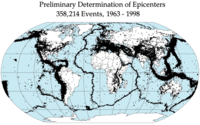
Photo from wikipedia
Surface roughness significantly affects the shear behavior of rock joints; thus, studies on the asperity damage characteristics and its influence on the shear behavior of joints are extremely important. In… Click to show full abstract
Surface roughness significantly affects the shear behavior of rock joints; thus, studies on the asperity damage characteristics and its influence on the shear behavior of joints are extremely important. In this paper, shear tests were conducted on tensile granite joints; asperity damage was evaluated based on acoustic emission (AE) events; and the influence of asperity damage on joint shear behavior was analyzed. The results indicated that the total AE events tended to increase with normal stress. In addition, the asperity damage initiation shear stress, which is defined as the transition point from slow growth to rapid growth in the cumulative events curve, was approximately 0.485 of the peak shear strength regardless of the normal stress. Moreover, 63–85% of the AE events were generated after the peak shear stress, indicating that most of the damage occurred in this stage. Both the dilation and the total AE events decreased with shear cycles because of the damage inflicted on asperities during the previous shear cycle. Two stages were observed in the normal displacement curves under low normal stress, whereas three stages (compression, dilation and compression again) were observed at a higher normal stress; the second compression stage may be caused by tensile failure outside the shear plane. The magnitude of the normal stress and the state of asperity are two important factors controlling the post-peak stress drop and stick–slip of granite joints. Serious deterioration of asperities will stop stick–slip from recurring under the same normal stress because the ability to accumulate energy is decreased. The AE b-value increases with the number of shear cycles, indicating that the stress concentration inside the fault plane is reduced because of asperity damage; thus, the potential for dynamic disasters, such as fault-slip rockbursts, will be decreased.
Journal Title: Rock Mechanics and Rock Engineering
Year Published: 2017
Link to full text (if available)
Share on Social Media: Sign Up to like & get
recommendations!